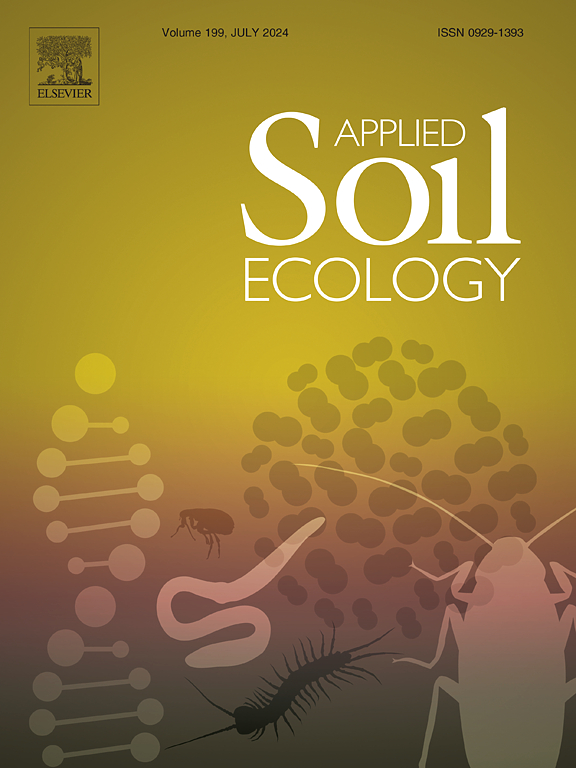Vermicompost and Azotobacter chroococcum amendment of saline-alkali soil decreases nitrogen loss and increases nitrogen uptake confirmed by ZmNRT1.1B of maize
IF 4.8
2区 农林科学
Q1 SOIL SCIENCE
引用次数: 0
Abstract
Globally, enhancing nitrogen (N) retention and optimizing N utilization efficiency in saline-alkali soils are crucial for sustainable agricultural practices and food security. This research aims to address the challenges of significant N loss and suboptimal N utilization efficiency in maize planted in saline-alkali soil. Employing soil column cultivation assays and maize lines with a ZmNRT1.1B loss-of-function mutation, we investigated the impacts of vermicompost and Azotobacter chroococcum on N loss mechanisms (including NH3 volatilization and 15N leaching) and therefore maize N uptake efficiency. The results showed that combined application of vermicompost and A. chroococcum reduced total NH3 volatilization by 35.0 % through lowering pH and Na+ levels, and enhanced cation exchange capacity (CEC). Additionally, this treatment increased soil organic carbon (SOC) content and promoted the formation of macroaggregates, thereby reducing 15N leaching into deeper soil layer by 35.0 %–48.0 %, which led to the increase of soil available 15N by 7.91 %–8.84 %. Furthermore, this amendment enhanced the shoot and root biomass by 88.0 % and 45.2 %, respectively, and increased the total N uptake by 36.7 % of wild-type maize, likely due to increased soil available N and a reduced Na+/K+ ratio in root. The improved 15N uptake in maize was linked to the activation of the ZmNRT1.1B gene, as evidenced by the growth inhibition and reduced N uptake in maize with a ZmNRT1.1B loss-of-function mutation. Collectively, vermicompost and A. chroococcum mitigate N loss in saline-alkali soil, thereby increasing stored available N and promoting N uptake and maize growth. These strategies significantly improve the effective management and utilization of sustainable N resources in saline-alkali soils.

在全球范围内,提高盐碱地的氮素(N)保持率和氮素利用效率对可持续农业实践和粮食安全至关重要。本研究旨在解决在盐碱土壤中种植的玉米氮损失严重和氮利用效率不理想的难题。我们利用土壤柱状培养试验和 ZmNRT1.1B 功能缺失突变的玉米品系,研究了蛭肥和根瘤酵母菌对氮损失机制(包括 NH3 挥发和 15N 沥滤)的影响,以及对玉米氮吸收效率的影响。结果表明,联合施用蛭石堆肥和褐藻褐球菌可通过降低 pH 值和 Na+水平以及提高阳离子交换容量(CEC),使 NH3 总挥发量减少 35.0%。此外,该处理还增加了土壤有机碳(SOC)含量,促进了大团聚体的形成,从而减少了 35.0 %-48.0 % 的 15N 向土壤深层的沥滤,使土壤可利用的 15N 增加了 7.91 %-8.84 %。此外,这种改良剂还使野生型玉米的芽和根的生物量分别增加了 88.0 % 和 45.2 %,总的氮吸收量增加了 36.7 %,这可能是由于土壤中可利用的氮增加以及根中 Na+/K+ 比率降低所致。玉米对 15N 的吸收率提高与 ZmNRT1.1B 基因的激活有关,ZmNRT1.1B 功能缺失突变的玉米生长受抑制且对 N 的吸收率降低就是证明。总之,蛭石堆肥和 A. chroococcum 可减轻盐碱土壤中的氮损失,从而增加储存的可用氮,促进氮吸收和玉米生长。这些策略大大提高了盐碱地氮资源的有效管理和可持续利用。
本文章由计算机程序翻译,如有差异,请以英文原文为准。
求助全文
约1分钟内获得全文
求助全文
来源期刊

Applied Soil Ecology
农林科学-土壤科学
CiteScore
9.70
自引率
4.20%
发文量
363
审稿时长
5.3 months
期刊介绍:
Applied Soil Ecology addresses the role of soil organisms and their interactions in relation to: sustainability and productivity, nutrient cycling and other soil processes, the maintenance of soil functions, the impact of human activities on soil ecosystems and bio(techno)logical control of soil-inhabiting pests, diseases and weeds.
 求助内容:
求助内容: 应助结果提醒方式:
应助结果提醒方式:


